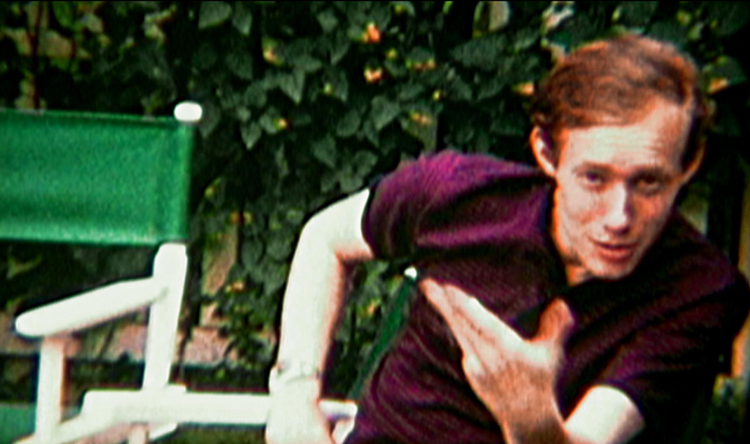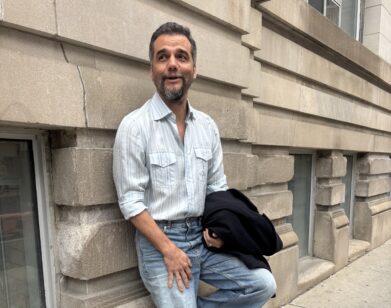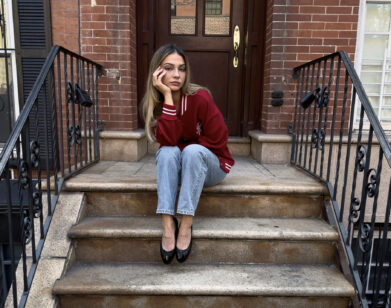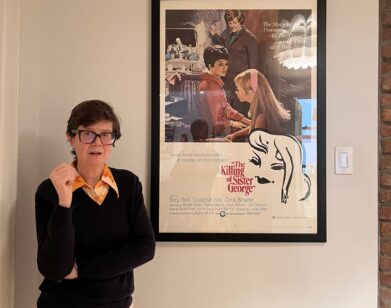Alexander Olch, Untied

Wallace Shawn and Alexander Olch. Photo by Matthu Placek
Alexander Olch is best known as a men’s neckwear designer (a niche role, certainly)—but expect that to change starting Wednesday, when The Windmill Movie, his feature-film debut, premieres at Film Forum. (It will also run on HBO this winter.) An affectionate, deeply personal portrait of the late Richard Rogers, an experimental filmmaker who was also Olch’s film professor at Harvard, it’s already earned a Writer’s Guild nomination for Best Documentary Screenplay. Interview talked to the multi-tasking director about juggling film and fashion, and the emotional experience of sifting through a departed friend’s “creative artifacts.”
DARRELL HARTMAN: The Windmill Movie is about a guy who struggled for 25 years to make a film that was a completely honest portrait of himself. Is this always a hard thing to do? Or was it especially difficult for him?
ALEXANDER OLCH: I think it’s a little bit of both. This guy had no problem making films about William Carlos Williams for PBS or other films about artists. But looking at himself, that was far more fraught with problems.
DH: Such as?
AO: The center of the film had to be him, but he didn’t want to put himself in it because he thought it was so stupid, so self-indulgent. Even if you’re not really hung up by that, though, it’s still a tremendously difficult film to make. Specificity and action are the obvious things that translate into cinema-robbing a bank, kissing a girl. What’s being captured here? Memory, summer, beauty. These are really hard things to capture in the form of images.
Still from The Windmill Movie
DH: Speaking of those motifs, this film reminded me in many ways of The Diving Bell and the Butterfly.
AO: Well, I’m honored and delighted. It’s a similar enterprise-much of the film is being constructed through voiceover; there are remnants of the past, similar architecture. And a lot of people commented on the scene in the hospital with the French nurses.
DH: Obviously, you were already well into this movie when Diving Bell came out. So which films did you look to for inspiration?
AO: As far as I can tell, there are really only two other films in this genre-taking an existing body of footage and making a film using these pieces that are left behind. F for Fake, which is an amazing Orson Welles film; he bought a lot of footage for a documentary that never got made about an infamous art forger who lived in Ibiza. And Grizzly Man. This guy, Timothy Treadwell, shot all this footage and [Werner] Herzog comes in. It’s not like he’s making Treadwell’s film—he’s clearly making his own film. Both are using the device of the voiceover over that footage, and there’s this weird magic that happens in both.
DH: I see what you mean. But I also think there’s something more personal, more intricate about your film.
AO: This one loops back on itself even more. It’s about a guy making a film about a film he can’t figure out how to make. I thought it was very uncharted territory.
DH: What was it like going through all those boxes of shooting logs and old footage?
AO: It’s definitely a powerful and eerie experience to be not only going through the belongings of someone you were close to, but the creative artifacts that person has left behind. You end up sort of taking a step into his mind. What was left behind was just rolls of landscapes and girls playing tennis and people sailing, and a couple interviews here and there. But nothing really seemed to add up. I’m there at his desk, with his pencils, feeling so completely close to him, and yet here’s this material that is so mysterious. It created this kind of draw.
DH: How did you choose the title?
AO: Dick referred to it as “The Wainscott Film,” but his boxes were often labeled “Windmill.” And it seemed to capture the quixotic nature of the project itself.
DH: You got a lot of help from Rogers’s wife, the photographer Susan Meiselas, and his friend Wallace Shawn. Who else weighed in?
AO: Ross McElwee—his advice was extremely important to me. He was another teacher of mine at Harvard. His most famous film as Sherman’s March. And he’s kind of the real father of the personal film, where you are the guy behind the camera and it’s narrated by you. Michael Moore doesn’t really make personal films, but he freely admits that he basically appropriated Ross’s style.
DH: You spent years making this film. Didn’t that feel like a big risk?
AO: It’s very time-consuming. There are thousands of ways to do it badly and very few ways to do it well. But this guy was making an experimental film, so really the only way to make a film about him was to experiment. A more well-traveled path would be making this about me: “My name’s Alex, I’m struggling to make this film.” But that takes away from the power, because you don’t care who I am. It’s not like he’s my dad. It’s not like My Architect.
DH: What do you have in mind for your next film?
AO: I’m choosing between two. One is about a classical music composer and the other is about a film director. These are both fiction films. I’m not sure I’m going to be going back into the realm of documentary. For me, what is most interesting is that attempt to fully execute some hare-brained idea that came into your head.
DH: You studied film in college, not fashion. How did you end up becoming a necktie designer?
AO: It really was not by design, as it were. My idea was to make a necktie as a souvenir for the crew that worked on Artemin Goldberg. But all my friends getting real jobs as bankers or lawyers heard about this tie and it became a sort of hit for newly arrived Harvard graduates in New York. I was a starving filmmaker and this became a steady little business.
DH: Won’t filmmaking force you to give it up at some point?
AO: I’ve always assumed that the two are not mutually exclusive. I can still design these collections. To connect a necktie to a movie, that line is longer. But to connect a fashion company to a film project-in this day and age, there’s plenty of examples. Agnes B has done it. No one blinks an eye when Lagerfeld makes a short film for Chanel. The fashion companies are really the ones, I think, that are most ahead of the curve.
DH: But wouldn’t you say fashion isn’t as closely linked to the world of feature filmmaking as, say, the art world is?
AO: It is quite a split. I’m a fan of Diving Bell. Schnabel is a hero of mine; there’s a guy who’s succeeded in two of the most competitive fields that there are. But I like to think that I’d take that even a step farther, because a much greater portion of the population would not necessarily call fashion art. And to be thinking about a story and a collection—I don’t know if it’s right or left brain, but it’s definitely different parts of the brain.
The Windmill Movie opens June 17. Film Forum is located at 209 West Houston St, New York.






